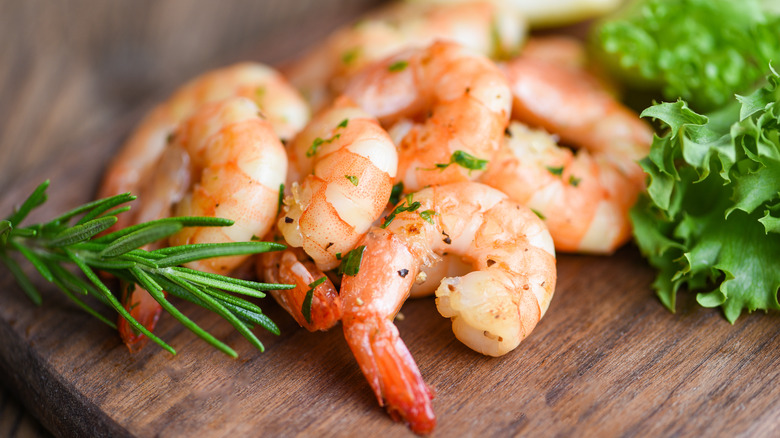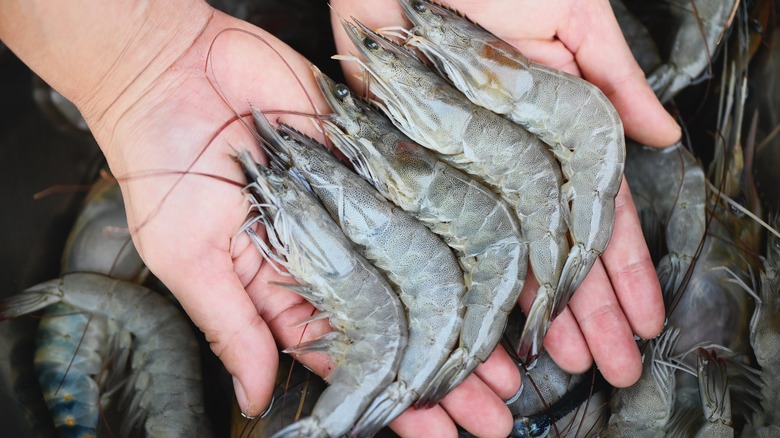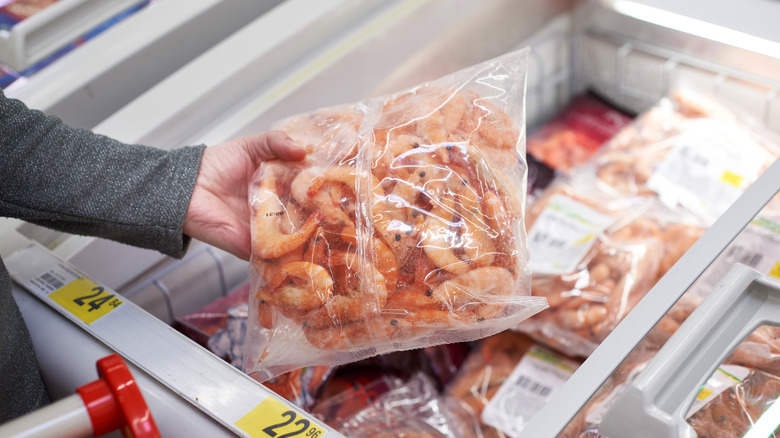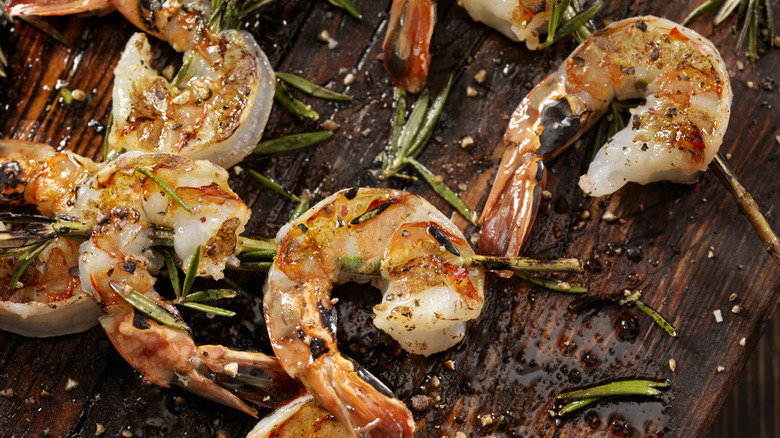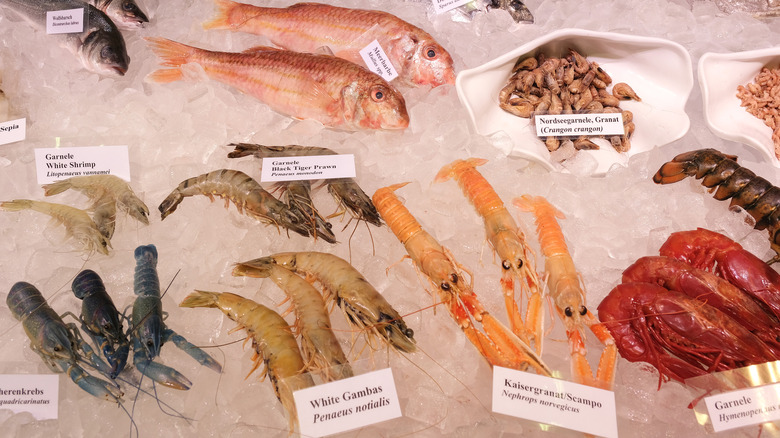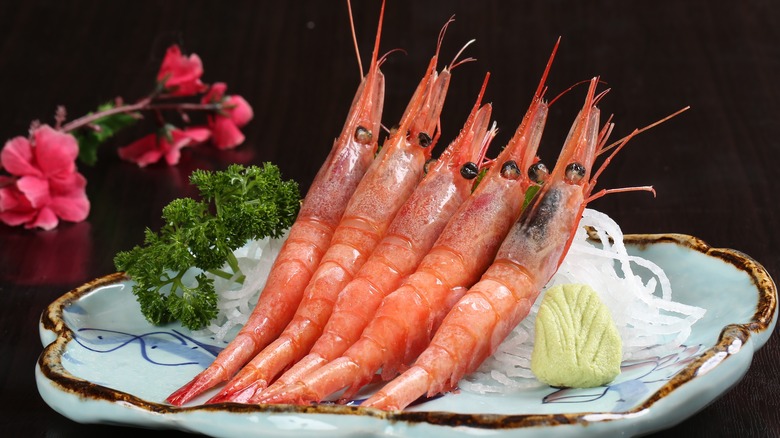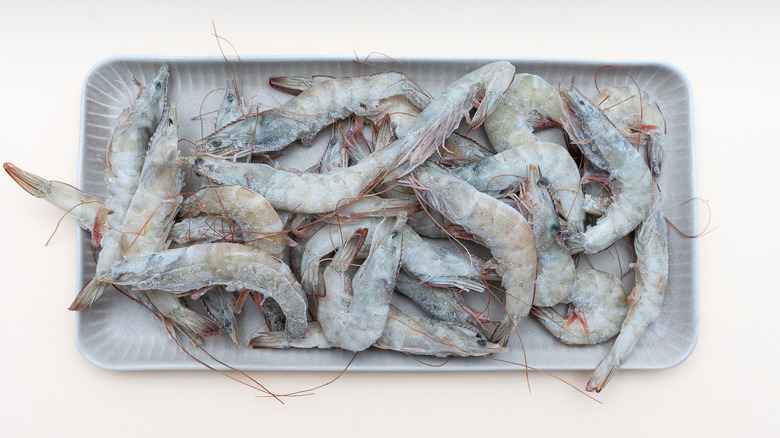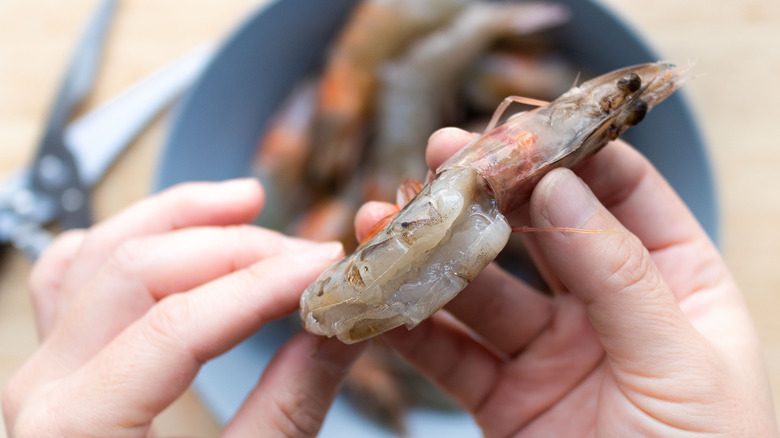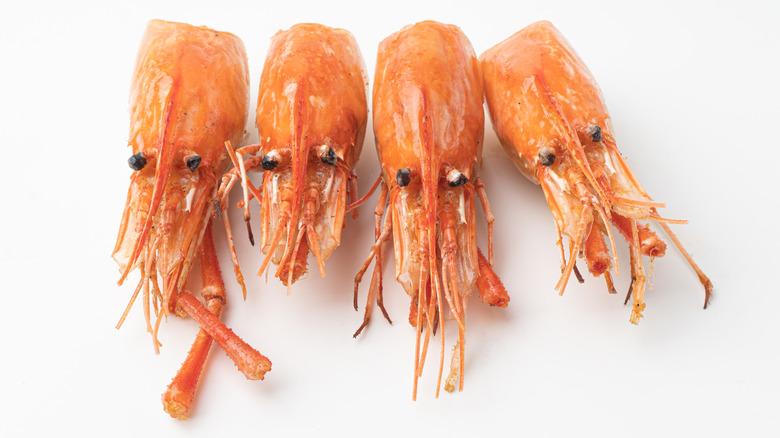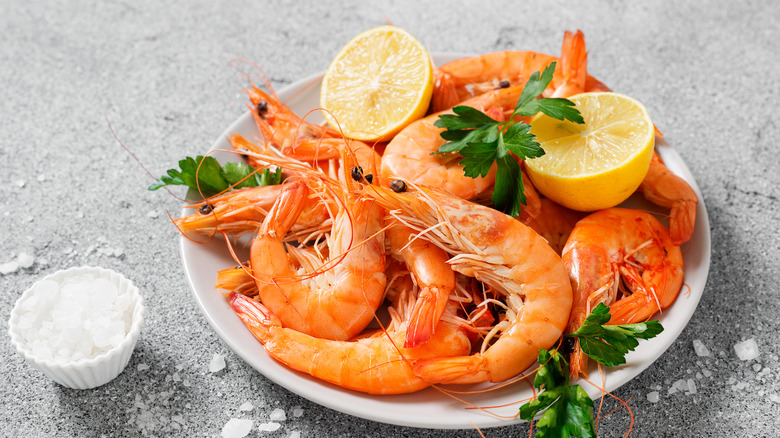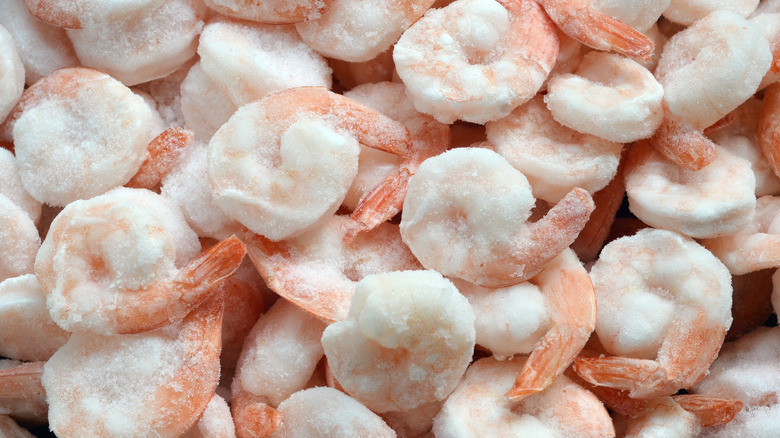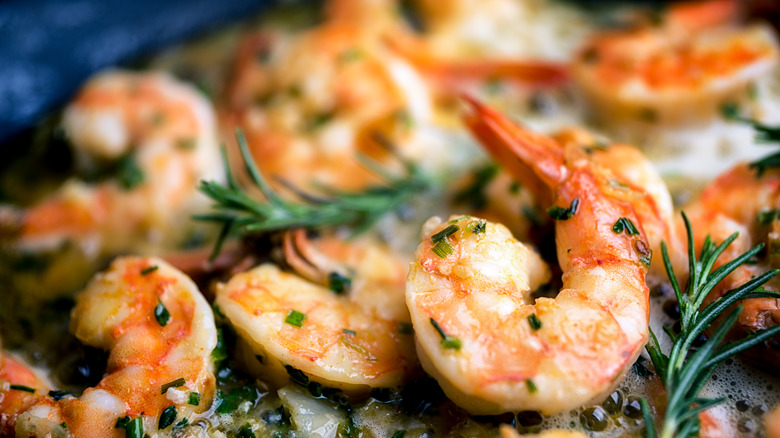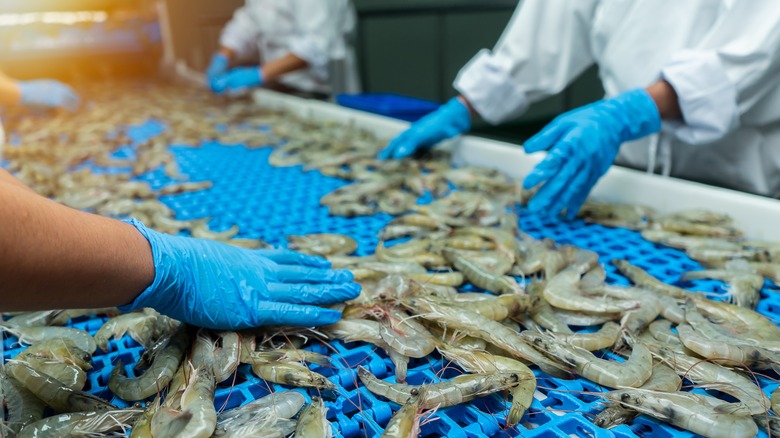False Facts About Shrimp You Thought Were True
Americans love shrimp. This tiny crustacean is a favorite seafood option in the U.S. The tender meat and creamy sweetness agree with most everyone, even those not big on fish and other shellfish. Shrimps cook quickly, freeze well, and are widely available in fresh or frozen form. An additional plus is its versatile nature. It's difficult to decide whether we like it better nestled inside cocktail sauce, enveloped with a crispy batter, drowned in gumbo, or doused in a rich, aromatic sauce that's best scooped with some crusty bread.
Despite all this love and the fact that it is a staple on American menus, it seems that shrimp is still largely misunderstood. Perhaps this stems from the incredible varieties from around the world worth cooking – there are more than 3,000 species of shrimp — and its importance on a global scale, but shrimp are often a subject of some common misconceptions and erroneous theories. We're here to expose many of the false facts that people frequently associate with shrimp. We'll start with the wrong classification in the animal world and end with its nutritional profile. Stick with us as we uncover some of the false information related to shrimp you should stop believing.
False: Shrimps are just smaller prawns
Many people believe that shrimps and prawns are the same thing and that the terms are nothing more than regional names used for the same animal. The belief that shrimps are just a smaller variety of prawns is even more common. Though these two crustaceans obviously resemble each other, there are real differences between shrimp and prawns. They are two separate species with different characteristics, and they belong to different suborders in taxonomy.
The easiest way to distinguish the two is by the claws. Shrimps and prawns have 10 legs, but while shrimps have only one pair of legs with claws, prawns have three pairs that end with miniature pinchers. Both animals are protected by a thin shell, but shrimps generally have a more curled shape. They also don't tend to share the same habitat. Though both are suited for fresh and salt water, shrimps mostly come from saltwater, while prawns are better equipped for freshwater. Prawns also tend to be slightly bigger, while shrimps are generally smaller, though both vary in size.
Taste-wise, there is little difference between the two, and in most cases, they can be used interchangeably. Shrimps are generally cheaper and more available, so you might find them better suited for home cooking as a budget-friendly option. If you need a bigger size and plumpness, you are better off with prawns, which also tend to be slightly sweeter, but this all depends on the variety.
False: You can trust descriptive size labels on packages
If you have ever bought a bag of shrimps or are even partially familiar with these delicious crustaceans, you've probably stumbled upon terms such as colossal or jumbo shrimp. Though this seems like a great way to navigate various shrimp sizes, you'll be disappointed to learn that those cute descriptive labels are not a very helpful reference. The truth is that this descriptive sizing system has never been standardized, so it cannot be a reliable guide when you want to buy a specific amount of shrimp.
What you need to look for is the shrimp count. These numbers typically show something like 26/30 and tell you the approximate number of shrimps per pound. To put it more simply, if you buy one of these bags, you can expect to find 26 to 30 shrimps in one bag, collectively amounting to one pound. This number is more precise because the size of the shrimp also depends on whether it is sold with the shell and the head. You'll also sometimes stumble on the U/15 label, meaning the package has 15 or fewer shrimps.
The descriptive labels might be a good indicator. However, as the system is largely unregulated, the term colossal can mean different things to different producers. If you need a specific amount, always rely on the numerals written on the package.
False: Bigger shrimp means bigger flavor
We are usually taught to believe that size matters, especially when it comes to food, and it's no different when it comes to shrimps. We generally rank large, plumpy shrimps perched around a shrimp cocktail glass much higher than any small shrimps used for pasta sauces or the classic shrimp scampi. Our generalization about the size is also fueled by the fact that giant shrimps usually command higher prices, which reflects on the marketing and promotes jumbo shrimps as something more valuable, immediately cementing their prized status. However, like most things in life, not everything is in the looks, and those small shrimps may pack much more flavor than the picture-perfect colossal shrimp.
Generally, smaller shrimps are probably younger, and in the sea world, this usually means that they are juicer, fresher, and much better tasting than older sea creatures that have lost their vigor. Along with having a fresh and sweet flavor, smaller shrimps tend to be soft, tender, and bordering on buttery, which significantly contributes to the overall flavor. These smaller varieties may not be the ultimate all-rounder for every recipe, but if you're going for the flavor and not the looks, they should be your first choice.
False: All shrimp taste the same
What we collectively call shrimps encompasses a large group of animals, but we are generally familiar with a much smaller number that is caught or harvested and then used for cooking. The usual premise is that all varieties on the market taste the same, but this couldn't be further from the truth. Many factors contribute to the overall flavor of shrimp, including the size, whether it came from sweet or salt water, and the age. All of them, together with the inherent flavor profile, create a wonderfully diverse group that differs in many ways, taste being one of them.
We generally classify shrimps into white, pink, and brown, the three main categories in the American market. White shrimp comes from all sides of the world, and you can easily recognize its mellow sweetness. Pink shrimp likes the cold and usually has a neutral profile with little minerality. Brown shrimps are caught in the Atlantic or the Gulf of Mexico and typically have a subtle flavor with a noticeable mineral bite. It's also worth mentioning the well-known tiger shrimp with its distinct fishy taste and the lobster-like, sweet rock shrimp that inhabits cold waters and is usually caught wild. These are only some of the most popular varieties that show how wonderfully diverse shrimps can be.
False: You can't eat raw shrimp
Raw seafood has always been a sensitive culinary topic that regularly raises eyebrows and squeamish reactions. Luckily, the internationalization of sushi has somewhat helped push eating raw seafood into the mainstream. However, there are still many doubts, especially about eating raw shrimp and the possible health risks related to it. Despite several opposite claims, you can eat raw shrimp, and though it's not such a common sight stateside, several cuisines, namely Japanese and Italian, preserve the tradition of eating shrimp and shellfish raw.
One variety particularly suitable for fresh consumption is the amaebi, commonly known as sweet shrimp or spot prawn, which is the best type to buy. You can occasionally see this variety used in shrimp sushi. High-end sushi joints will also opt for botan, a variety praised for its sweetness and delicate texture. Remember that when mixing shrimp with citrus juice or other acid commonly used to make a simple ceviche dish, you should be even less concerned, as this acidity partially cooks the seafood.
It is generally recommended to avoid eating grocery store and frozen shrimp raw. However, if you ever come across freshly caught shrimp or spot raw shrimp on the menu of reliable restaurants where you are confident that they serve top-grade fish, go ahead and enjoy the juicy sweetness and melt-in-the-mouth meat.
False: Stay clear of frozen shrimp
Similar to the bigger is always better narrative, the line we are usually told is that fresh is always superior to frozen. Though this might be true for some ingredients, the truth is that frozen shrimp is, in most cases, a much better option.
Fresh shrimp is great, but the chances of you finding those juicy, freshly harvested shrimps are very unlikely. What is usually labeled and sold across the U.S. as fresh shrimp is mostly likely frozen and thawed before being sent to the market stalls. As shrimp is such a perishable shellfish, this means that you'll have to use it immediately and that some of its good qualities have probably been lost along the way. Also, you're never sure whether the shrimp was thawed correctly or how long it has been sitting around. This is where frozen shrimp comes up as the superior option. Shrimps are frozen at their prime. Most producers freeze them immediately, meaning your frozen pack comes with fresh, plumpy shrimps that did not get the chance to deteriorate. An additional plus is that you do not have to use it immediately and can thaw it properly. Check out our frozen shrimp tricks you'll wish you knew sooner.
Frozen shrimp is not only better in quality but also tends to cost less than fresh shrimp, so it's usually a budget-friendly alternative. For the best option, look for an IQF (individual quick freezing) label that packs quick-frozen individual shrimp.
False: The vein is inedible
Whenever someone mentions cooking shrimps, there is talk about a visible vein that spreads across the shrimps' back. Though the general recommendation is to remove the vein, whether before or after cooking, it is not true that it is inedible. You can eat the vein without consequences if the shrimp is boiled, fried, or steamed. The only thing you might get is the occasional gritty mouthfeel usually associated with bigger and more visible veins.
The vein is the shrimp's digestive tract. Depending on the type of shrimp, size, and age, the line can be more prominent and visible, but you'll notice that some varieties have a barely noticeable streak in the back. Removing the vein from a peeled shrimp is a fairly easy process, but it does require some time, as each shrimp has to be processed individually. Removing the vein of whole, shelled shrimps is a little more complicated but possible. If you want to remove the vein, it's always best to do this before you cook the shrimp. However, if you can't be bothered with these tasks, leaving it in is perfectly okay if you are not squeamish. For those who don't want to clean it but also can't process eating an animal's digestive tract, the best solution is to buy deveined shrimp.
False: You should not eat a shrimp's head
Shrimp meat is beautifully tender, succulent, and sweet, favored even by those who usually avoid seafood. But among the true hedonists, the shrimp head is the best part of the animal, typically heralded as the ultimate treat and a real delicacy. Though not ideal for the fainthearted, the inside of the shrimp's head is edible and creates a spectacular medley of flavors best described as a combination of sweet and salty, with hints of some nutty and earthy nuances. Though Americans are not too big on the head-to-tail philosophy, and most restaurants serve shrimp without the shell and the head, the situation has been slowly changing. So the next time you see a whole shrimp on the menu, don't be afraid to tackle one. You'd be surprised to discover how much flavor is hidden in that tiny shell.
If you get the whole shrimp served and you want to try it, you first have to remove the head from the body and then vigorously suck out everything in the head in one go. You can do this with cooked or raw shrimp. True fans should know that the shrimp's head can be tossed in flour, fried, and served as a crunchy snack or an appetizer.
False: The shell has no impact on flavor
When buying shrimp, we are usually led by the thought that peeled shrimps make cooking a hassle-free experience. The shell is thought of as something unnecessary that does not contribute to the overall eating experience. But this is another false fact that is usually associated with shrimps.
The truth is that the shells can easily upgrade the flavor of cooked shrimp. Despite the unassuming looks, they contain various compounds, minerals, and sugars that are amped up during cooking and eventually get into the meat. Besides the flavor component, shells are also beneficial because they preserve the meat during boiling, steaming, or frying. This means that despite the high heat, the meat will remain soft, plump, and juicy. As dryness is a common scenario with shrimp, this seems to be a foolproof method to always end with perfectly cooked shrimp. The moral of the story here is that next time, reach out for the shell-on shrimp for your cookout. Though they need a little more effort afterward, they will make up with more flavor and better texture.
False: The easiest way to defrost shrimp is in the microwave
The microwave is a trusted companion when you need to defrost meat or veggies, but despite the common belief, it's not the best option for defrosting shrimp. This powerful kitchen tool is loved because it is fast and efficient, but shrimp are usually too tender and too small for such an aggressive treatment. In most cases, the heat will defrost them too quickly, and you will commonly find that some pieces have been partially cooked and turned into gummy and chewy rubber, which you definitely want to avoid.
There are much better options to defrost shrimp. In an ideal situation, you will remember to pull it out of the freezer the day before, as it's best to leave the frozen shrimp in the fridge to defrost at a constant, controlled temperature. If you are not one of those organized unicorns who remembers to do this, there is a solution. Leave the shrimps inside their well-sealed package or transfer them into a zip bag, and nestle the whole thing in a bowl filled with cold water. Depending on the size of the bag and the shrimp, you can expect that they will defrost in an hour or two. With this method, you should never use hot or boiling water as that can also cook the shrimp. Your bag will want to float in the bowl, but just press it down with a skillet or other heavy appliance.
False: Shrimp is not healthy because it's high in cholesterol
Nutritionally, shrimp is rich in cholesterol, but that does not mean it is an unhealthy option. On the contrary, shrimp is generally low on calories, and a serving of approximately 3 ounces of shrimp packs around 84 calories. This tiny crustacean also has a lot of protein, reaching approximately 20 grams per portion. It is also a great source of many vitamins and minerals, such as potassium, iodine, phosphorus, and magnesium.
Despite all the benefits, shrimp sometimes gets a bad rep because a portion packs around 160 milligrams of cholesterol. Though this number sounds alarming, it should be highlighted that shrimps don't have a lot of saturated fats and are also a great source of omega-3 fatty acids, which are generally beneficial for our health and well-being. Though we can't deny that these flavorful crustaceans are high in cholesterol, we also can't say that they are unhealthy or damaging to your health. Shrimps pack many good nutrients and can be a great addition to your diet.
False: Farmed shrimps are not sustainable
Shrimp sustainability became a hot topic once shrimp went mainstream. The great debate usually revolves around wild and farmed shrimp, and you'll often come across uninformed generalizations that classify wild shrimp as better and more sustainable, while farmed shrimp is usually labeled as the bad guy that ruins animal habitats. But the truth is a bit more complex than that.
Overfishing, climate change, bycatch, and the overall changes in seas and oceans have made wild-caught shrimp a rare sight on our menus, and without fish farms, we would not be able to fulfill the market needs. And though fish farms have long cultivated a bad reputation thanks to unsustainable practices, questionable work ethics, and low-quality products, the situation has slightly changed for the better, and you can now find shrimp that come from sustainable aquatic farms.
Most farmed shrimp come to the U.S. from foreign markets and can greatly vary in sustainability and quality. Though it can be challenging to check the sources and know their practices, look up brands listed by the Seafood Watch or any other organizations that promote and award certifications to farms that run fair and sustainable businesses. Or just find a fishmonger you can trust so you can always have top-quality shrimp at hand.
